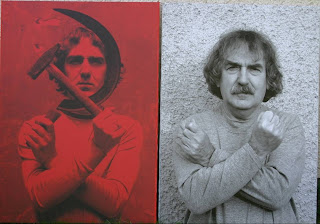Book accompanying the exhibition (published in English)
Proposed title: Overcoming Dictatorships? Visual responses from five post-communist countries with comparison to Post-fascist Italy
Authored by Jutta Vinzent with contributions from Nellie Gilson and Antonia Grosdanidou
Published by Kerber Verlag, Leipzig
96 pages with 30 illustrations (in English)
Structure (Sept. 2007)
Introduction (with a historiography to the topic, methodology and the reference to the EU project and its workshop, i.e. that this structure is a result of the artists’ discussion in Poland)
Chapter One:
a) What are the processes of overcoming and what is ‚overcoming’ for the participating visual artists and visible in the art works (mourning, remembering, overcoming/overtaking, remnants of the old system)
b) Generational gap – older and younger artists
c) The changes that took place as individual stories both in terms of each country/government (in the light of the visual arts) and each artist
Chapter Two:
The Present: New Dictatorships (religions, economic dictatorships, art and dictatorships in terms of medium, networks, globalisation and the definition of ‘artist’) – as reflected in the visual arts and art market and in the exhibits of the exhibition show.
Conclusion
Biographies of the artists (by Nellie Gilson and Antonia Grosdanidou)
Timeline of the countries with dates significant to the topic
Index
Buch zur Ausstellung (Deutsche Version)
Arbeitstitel: Überwindung der Diktaturen? Zeitgenösische Kunst aus sechs post-kommunistischen Ländern
Autorin: Jutta Vinzent mit Beiträgen von Nellie Gilson und Antonia Grosdanidou
Verleger: Kerber Verlag, Leipzig
Format: 96 Seiten mit 30 Illustrationen (Veröffentlichung in Englisch)
Plan/Struktur des Buches (Stand: Sept. 2007)
Einführung (mit Historiographie zum Thema/Titel, Methodenbeschreibung und Hinweis auf das EU-Projekt, d.h. dass die Struktur/Themen der Einführung aus dem Gespräch der Künstler auf dem Workshop in Polen resultiert)
Kapitel Eins:
a) Welche Art von Prozesse sind involviert in der ‚Überwindung’ für die Künstler involviert und wie drückt sich das in ihrer Kunst aus (Trauer um das Verlorene, Erinnerung, Überwindung/Vergessen, Übernahme des Einen oder Anderen aus dem alten System)
b) Generationenkonflikt – Spezifisches für jüngere und ältere an der Ausstellung teilnehmenden Künstler
c) Die Veränderungen gesehen als individuelle Geschichten hinsichtlich jedes teilnehmende Land und jedes Künstlers
Kapitel Zwei:
Die Gegenwart: Neue Diktaturen: religiöse, ökonomische, kunstmediumspezifisch (z.B. die Dominanz von Installationen und Videokunst), networks, Globalisierung und die Definition, was ein Künstler ist) – wie werden diese reflektiert in der Kunst, am Kunstmarkt und in den Beiträgen zur Ausstellung
Schluß
Biographien der Künstler (Nellie Gilson und Antonia Grosdanidou)
Timeline der Länder mit wichtigen Daten
Index































